
I've linked this video before, but here it is again.
Sometimes promotional material can push the envelope a bit in order to look good, and I admit that a few moments during this video I found myself thinking "Oh, really?"
Well, yes. Really.
Thanks go out to Des Esseintes for donating this coat from Francesco Smalto.
A few posts back I remember lamenting the fact that certain houses get way overhyped and others don't have anywhere near the recognition they deserve. Well, this is another of the latter. Perhaps because they have fallen to the all-too-common over-licensing of their name that they are more known for their scents; one is also tempted to think that the quality may not be the same as it was when this coat was made back in '91, but the video was posted in 2008 and shows identical techniques.
You can find a bit of background info on Smalto here
Men's tailoring is often focused on the understated, the invisible, but in this garment the details call attention to themselves; in this sense it is very influenced by haute couture whose finishing and execution are often shows of virtuosity rather than self-effacement. The main label, as shown above, has been incorporated in a clever pocket which would be just about impossible to replicate in a mass-production setting, and is just one of the many indications that this is a very special garment. That said, most of those clues are on the inside, not the outside.
Something less obvious, but which should be pointed out, is that this garment had spent several weeks crammed into a shipping box. It is not a heavy, sturdy cloth but rather something more delicate, and yet this is how it looks straight out of the box, no pressing or steaming-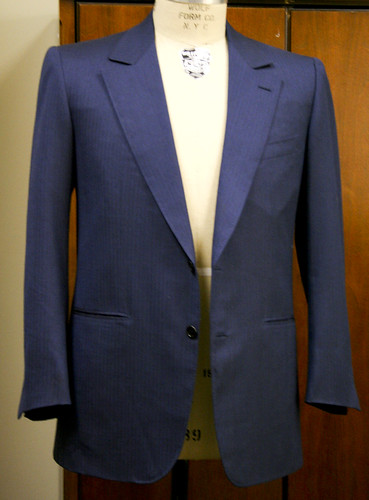
The shape of the lapel and collar is rarely seen outside of France.
Readers are, by now, aware of my thing for buttonholes and these are very good, worked using finer thread than I have ever been able to find; note the pickstitching along the vent and the little bar tack. Note also that the gimp ends have been worked inside the cloth rather than being concealed under the ends like I do.
This buttonhole on the front is as close to perfection as I have ever seen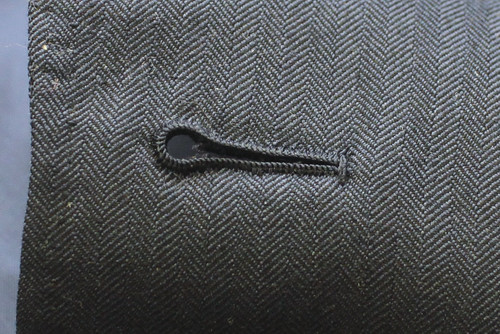
and oddly, the second buttonhole is straight rather than keyhole, an acknowledgement of the fact that this button must never be fastened.
The lapel is sporting the "milanese" buttonhole, the mechanics of which I have finally figured out (it came to me while driving home, of all places).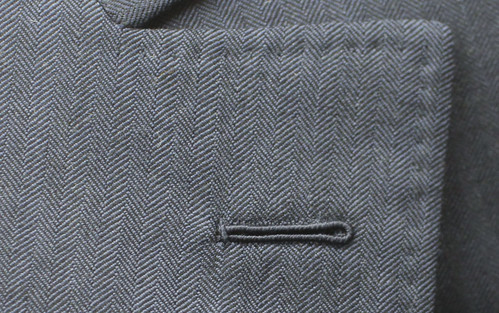
The pocket jets have been sewn by hand, something that is almost never seen anymore.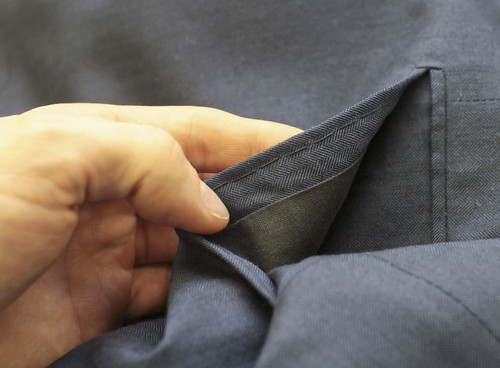
The inside pockets (there are four of them) have also been bound by hand. Notice the hand pick stitching along the edges of the lining and flap, and the hand-made buttonhole on the flap.
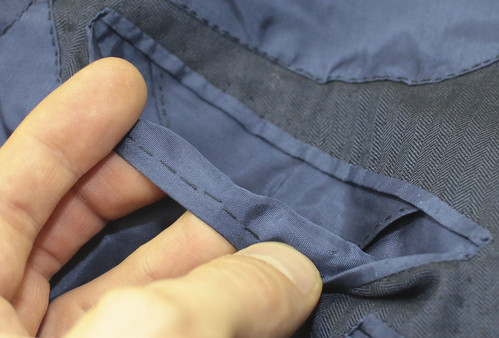
The lining has been inserted entirely by hand. While most English tailors prefer a small, invisible stitch to fell the lining, it is more common in Italy to use a decorative top stitch, like this one, however they are usually much wider in their spacing. These are very tight, another way of saying "we have spared no time nor effort in the creation of this garment". I, personally, prefer a neater, more discrete finishing stitch, but this is actually a more solid stitch.
The vents.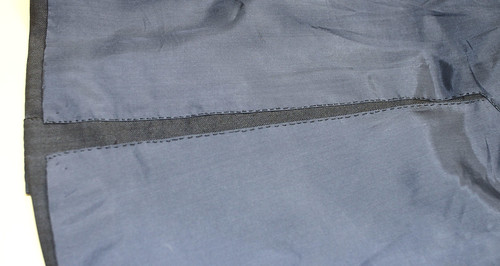
A few diagnol stitches
The pleat at center back has been finsihed with a big S for Smalto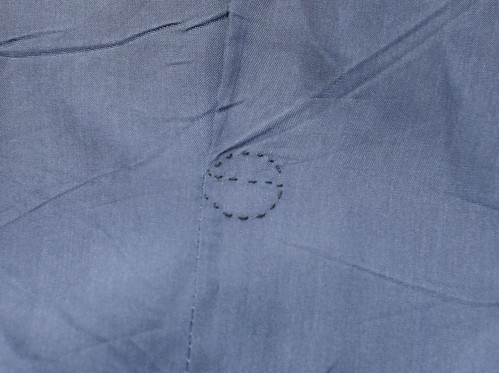
I was astounded to see a two-piece top collar, something which is rarely, if ever, seen on bespoke work because it requires a bit of engineering in the pattern. The blurb I linked to did mention his visiting clothing factories in the U.S. so he may have borrowed a technique.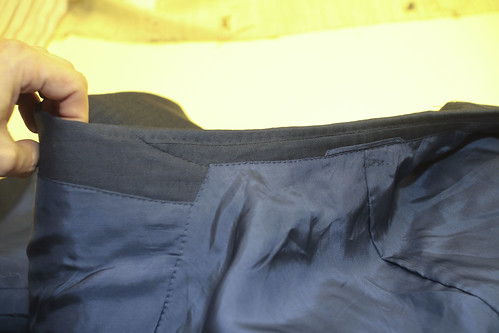
To the right of the personal label is the name Georges (I obscured the client's name). I imagine that this was either the cutter or the person who created the garment.
As I get the lining open, we see then vents have been reinforced with wiggan.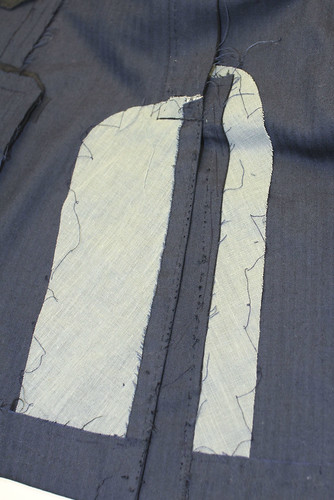
The large inlay has been pick stitched to one side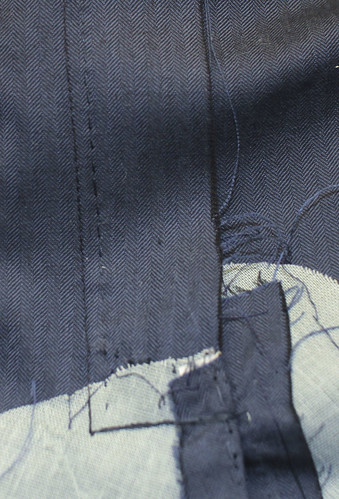
And the smaller seams in the body and sleeve have been lightly overcast by hand to prevent fraying, a detail I have never seen on a men's tailored garment but would be more common in ladies' couture. This is more commonly serged or pinked on men's garments.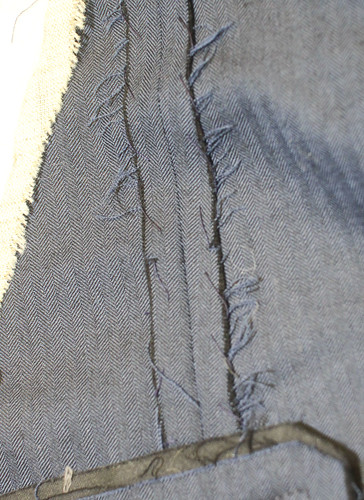
Rather than a loose basting stitch, the facing and pockets have been secured with a cross-stitch.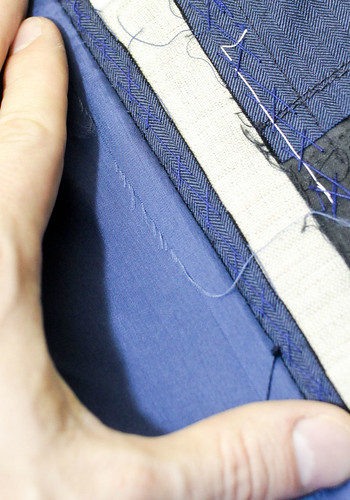
The lapel's underside is heavily dimpled which would indicate hand pad-stitching. And since, until now, virtually everything has been done by hand, one has no reason to suspect otherwise. So I was quite surprised to find that the lapel and collar had been padstitched by machine.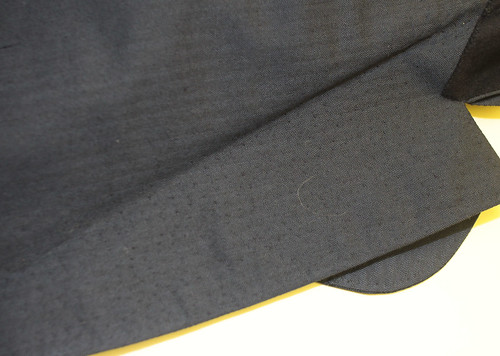

It is perhaps not apparent in the photo, but the chest has been padstitched by hand the entire length of the felt.
Likewise, the shoulder pad is entirely hand made.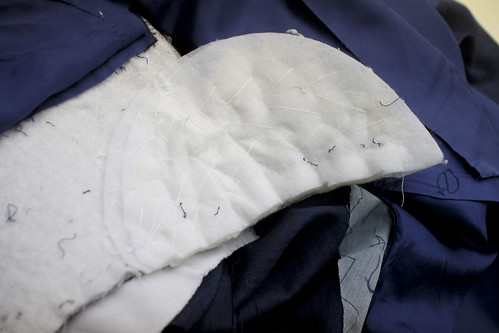
The edge tape has been sewn in by hand as well.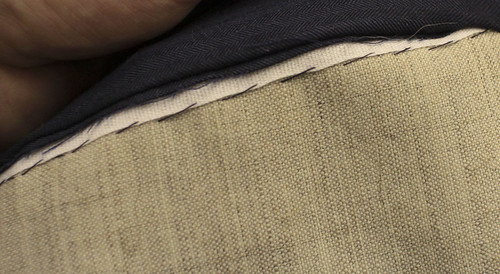
Considering the amount of work done by hand everywhere else on the garment, one can assume that they see no added value in padding the lapel and collar by hand. Liekwise the sleeve setting and shoulder seam have been done by machine (have we seen enough proof that this is really not necessary to do by hand yet?)
Here we can see the reverse of the pad stitching of the chest, as well as the seam that was taken to build some shape into the shoulder, instead of teh more common vees. Note the direction of the grain in the upper piece.
I could feel a nice amount of structure in the chest so was not at all surprised to find two layers of haircloth, one on a slight bias (refer back to my drape experiment) and the other cut out of the scye , à-la Anderson and Sheppard. Smalto had clearly seen a lot of things in his carreer.
I can honestly say that it's been a while since I saw a garment with such a personality. One might not agree with all the choices made, but it shows a definite point of view and I can certainly respect that, and find it refreshing for some reason. What was even more fascinating to me in discovering a lot of these very distinctive details was that, a few weeks later, I recieved a garment made by another French tailor which resembled the Smalto in many of them. There is certainly a strong link between the two and I am hoping that readers in Paris (or elsewhere) who may have more knowledge of the history of these two tailors will fill us in on them, once we have had a look at the second garment.
A la prochaine!








24 comments:
Merci!!!!!
ah the one i was eagerly awaiting! thank you jeffery, much appreciated. i look forward to your inevitable piece on the milanese buttonhole. now it's time for me to do some research on a two piece collar i think...
Even though I could do without those lapels or the machine padding, that finishing is amazing. The lining insertion, the pockets, and, most of all, that "S" tack really takes the cake. Thanks for showing us this coat and thanks to the donor.
When you say the pocket jets were sewn by hand, does that mean that the rectangle around them that is sewn before cutting them is hand sewn or just the pick stitching?
Thanks again, Jeffery. These deconstructions are so helpful. Now I know what I can aspire to, after 100 years of practice. :-)
More seriously, it's illuminating to be presented with photos of exemplary hand stitching. If all one sees is RTW it's hard to know what good work looks like.
And I'm a woman, so I have even less idea what constitutes a well cut and sewn men's garment.
I do enjoy my evening and weekend tailoring classes, though.
I am wearing one of my father's Smalto suits today. a Brown double breasted 6x2. the fabric is a very fine twill weave it was made in Sept 1983 it is oddly versatile. the jacket has brass buttons embossed with "Franchesco Smalto" It Has two pair of pants one in matching brown and one in a brown houndstooth.
I always feel special when I wear these suits.
Another thorough dissection with remarkablly detailed photos. Splendid work, Jeffery. Hope you're
keeping files of your work. It will make a marvelous book one of these days.
JMB
Carl,
I believe we established earlier on the London Lounge or somewhere else that there must be some family connection so far unbeknown to both of us: Apart froms the Smaltos, I also have a selection of handed-down Lanvin sur mesure shirts in my closet - unfortunately, neither the suits nor the shirts fit particularly well, and the required adjustments would go far beyond what would be reasonable (and, in the case of the suits / jackets, arguably beyond what is possible), so let's hope Jeffery turns his mind to dissecting shirts one day...
Jeffery - thanks for the wonderfully detailed and informative report again. I am glad I could make a small contribution! On the fabric: I am not sure I agree that the cloth is "rather more delicate" - while not exceedingly heavy, I found it rather sturdy and hard-wearing.
dE
Almost exactly like Camps de Luca; no surprise he spent time there.
Smalto worked at Camps in the 50's.
Camps was bought by de Luca in the 70's.
and of course Camps and de luca were not the same person...
I am quite lucky. The suits fit with only moderate alterations.
removed the cuffs on the pants to lengthen.
My right arm is longer then my father's was. my tailor pieced the sleeve from underneath. the buttonholes are a bit high up on the sleeve. I could have added another buttonhole, but where was I going to get someone to match that buttonhole. And i would have had to find replacement buttons that would have been inferior.
the LANVIN shirts do not fit me.
the Lobb shoes fit, but cause a little pain!
I have an assortment of Zilli coats and jackets.
One Zilli jacket is mink lined....
@Benjamin- the rectangle has been sewn by machine, then it is cut and the edges bound. Most people sew down the binding by machine- you can see the long, irregular stitches here were done by hand.
@BENEDICT17- Thank you. You know, I was recently contacted by a publisher who wanted to use one of my photos in a book. I went to look for the original full-res photo and found taht I had deleted all the original files, not thinking I would ever need them. Live and learn...
@Des Esseintes- again, thank you. This cloth is 7 1/2 or 8 oz, and is a 2x1 construction which is considered tissue paper by most English standards ;)
@Anonymous- I think we are about to find that there were a number of tailors who might have been at least influenced by Camps.
@Carl- I you are fortunate to have inherited all that clothing!
Very illuminating dissection.
Mack11211 here, donator of the Fallan & Harvey dissected previously.
I'm actually selling a Smalto bespoke coat and a pair of pants (consigned by Carl) on ebay now. Search 'smalto bespoke' and you will find them.
Is the similar coat from Creed?
Soo funny- I follow Your blog nearly every month and I was pretty curious about the special buttonholes, too. So I asked my last courses teacher on saturday how these work. He is a viennese Tailor since 53 years and of course he knew. He also told me, that these were usually made with the thicker (5 1/2) silk, because these threads wind softer around the gimp. (For us in Vienna it is hard to find such threads, because they are usually not produced anymore - even the gimp thread is absolutely impossible to get. grml. Thanks god some stores have very old unsold stocks where one can find the thicker threads in a few colours..) So, thank You for sharing!
In the you tube video, what is it that they "paint" on the press cloth before pressing the lapel?
@bill- That's water. We usually use heavy, 18-pound dry irons for finishing and by using daubers to apply water on the press cloth we can localize the steam generated more precisely.
Have you seen Valentino: The Last Emperor?
It's about Valentino Garavani and how he's one of the last couturiers.
Watching him and the seamstresses discuss the pieces is amazing. The fabrics are incredibly thin and sheer and the detail that goes into each garment. Those women have to find a way to construct something from his imagination, so they have to be so creative. It's really just crazy.
Here's a link to a bit of it. Doesn't do it much justice...
http://www.youtube.com/watch?v=gPCUEmhoybs&playnext=1&list=PL6F3F819FD0312436
Thanks Chloé
I saw that film- it's the sort of thing that both initially drew me and repulsed me from the couture. The level obsession over detail that is required often means personalities that are a bit, um, larger-than-life...
J
Hi Jeffrey, I will point my partner to this fabulous new post -- he's learning tailoring on his on from books, youtube, your posts, etc. Meanwhile I promised to ask you this question: re: hand stitching the hair cloth the tailoring book he's got says to "baste through all the layers to the jacket fabric" but he doesn't see how one is supposed to do that without the stitches showing through on the right side of the jacket front. In taking jackets apart were you able to observe how this stitch attaches to the jacket? I'm assuming it's got to be a very tiny stitch -- tinier than a pick stitch but anyway if you don't mind helping we'd appreciate it. Thank you in advance! And please don't stop posting -- we look forward to your posts :-).
I’m learning new things in bundles as there happens to be a lot of unique stuff here. I hope it will continue to deliver nice information.
Am I the only one who thinks that the hand stitching and finishing is a bit meh? I am not (could not ever be) a tailor, however I am a hand sewer and embroider and I am surprised that the stitches are not better in some instances. Disappointing overall and I'm afraid the mix and match with hand and machine stitching doesn't work for me either, no matter that it is only a small amount of machining.
How large is the teardrop pocket? Is it functional or just decorative?
From a scissors porn perspective, there is a lovely pair of shears early on being used to do some rather routine cutting, one might argue. Sure the fabric is the star of the show, but it is cut with wide allowances for seam allowance, right on through to possible areas where the client might put on weight before the suit is delivered.
After the initial cloth is cut, a number of to the edge cuts are made but from then on we see only plastic handled dreadfulls that are possibly of the highest quality, or possibly of low quality like the ones I buy for 2 dollars at the dollar store. These scissors are pretty good actually.
I draw from this:
1) Maybe these guys should sign up for a few more pairs of your expensive shears to project the right image about the work they are doing.
2) Maybe given that scissors are easily sharpened by any conscientious person, they shouldn't be saved from working with so many materials (though obviously the big shears are specialized, possibly to even a time before central heating). I have 400 dollar each carpenter chisels and I will cut anything with them given that I can sharpen them. I mean I cut anything they should cut. Visiting workman once used one to cut away a bolt on a furnace they were removing. Grrr!
3) I have a few skunk works projects in mind also.
Post a Comment